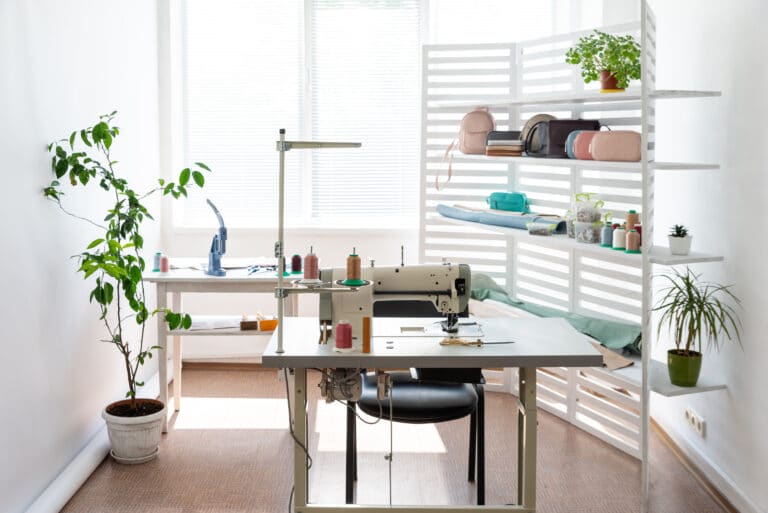What Is the Difference between Interfacing and Stabilizer?
Some of the links below are affiliate links. As an Amazon Associate I earn from qualifying purchases. This means that, at zero cost to you, I will earn an affiliate commission if you click through the link and finalize a purchase.
Wondering what is the difference between interfacing and stabilizer?
There are various significant differences between interfacing and stabilizer. One of these differences is that interfacing remains fused on a garment for the entire lifetime of the garment. Whereas stabilizer is removed once it has complete the job.
There are many different materials to help keep your fabric from fraying, to help make it stronger and to make it stiff and with so many different varieties on the market it is hard to know what is best to use and what each one does.
I decided to put togehter this quick guide to help you understand the difference between interfacing and stabilizer.
If you are looking at learning more about the differences between these materials, I have another post breaking down the difference between interfacing and fusible web.
What is Interfacing?
If you want to make a piece of fabric firm and give it shape, interfacing is the answer. Generally, interfacing is a fabric that you join on the wrong side of a garment so at to make it more stable.
If you have been sewing for a while now, you know that different garments have different degrees of stiffness. In the same way, interfacings have varying degrees of stiffness so as to match the garments they are joined with.
For instance, if a garment is heavy, the interfacing used has to be heavy as well. In most cases, interfacings are white in colour but they can also have a different colour other than white. However, rarely will they be coloured. For those who do commercial sewing, you will often use interfacing in collars, waistbands, and cuffs.
Interfacing is used to achieve various things. One of the major purposes of interfacing is to improve the look of a garment. If you have been doing sewing projects, you must have noticed the difference that interfacing brings on a garment.
Another reason to use interfacing is to give stability and shape to a piece of cloth. Some garments don’t have the much-needed stability and shape, so you have to reinforce such thorough interfacing. Especially when you are embroidering, it will be essential for you to use interfacing to increase the stability of a garment.
This will increase the quality of your embroidery work. Moreover, there are fabrics that are generally weak. For you to increase their quality, you have to use interfacing to make them stiffer.
This will give them a bit of shape and increase their level of stiffness so that they can have their quality improved. If you will also need to increase the level of heaviness on your fabrics, interfacing will do the job perfectly well.
What is a Stabilizer?
A stabilizer is a backing used on fabrics when stitching them to avoid stretching. It is an essential component in embroidery and sewing projects.
When your sewing machine’s needle is moving, the fabric will also be moving up and down but you have to hold it firmly so that you avoid stretching.
This is where a stabilizer comes in. It holds the fabric firmly, giving it shape and stability when stitching. In case of any movement, the stitching will be uneven; hence, affecting its quality.
For you to have quality stitches, especially if you are working on a commercial project, you should use a stabilizer to perfect your results. Once you are through with the stitching, you can remove the stabilizer since the fabric doesn’t need support anymore.
The stabilizer of your choice should be the right one for your project. For example, you should make sure that you choose a stabilizer that is sufficient for your fabric and the stitch count of the design you are working on.
There are three types of stabilizers including wash-away, cut-away, and tear-away. It is also important to point out that there are different weights of stabilizers. For the best results, you should make sure that you use the right weight.
For example, make sure that you use a weight close to the weight of the fabric you want to embroider. Similarly, choose the weight that is ideal to the design’s stitch count.
What this means is that if the stitch count is greater, the weight of the stabilizer should be heavier. It is recommended that you use an adhesive spray to temporarily hold the fabric well throughout the embroidery process.
What Is the Difference between Interfacing and Stabilizer?
There are various significant differences between interfacing and stabilizer. One of these differences is that interfacing remains fused on a garment for the entire lifetime of the garment.
This is not the case for a stabilizer. Usually, you remove a stabilizer after stitching because the fabric doesn’t need support anymore. Also, the manufacturing processes of both are different.
For a stabilizer, it is designed to be stiff. On the other hand, interfacing can be stiff in one direction while loosening up in the other direction.
These differences mean that there are special and unique purposes for each of them. Using each one where it is needed helps to improve the quality of your embroidery and sewing projects.
I hope you have found this guide helpful in deciding whether you need stabilizer or interfacing for your project. If you have any experience working with either or a particular brand I would love to know your thoughts.



